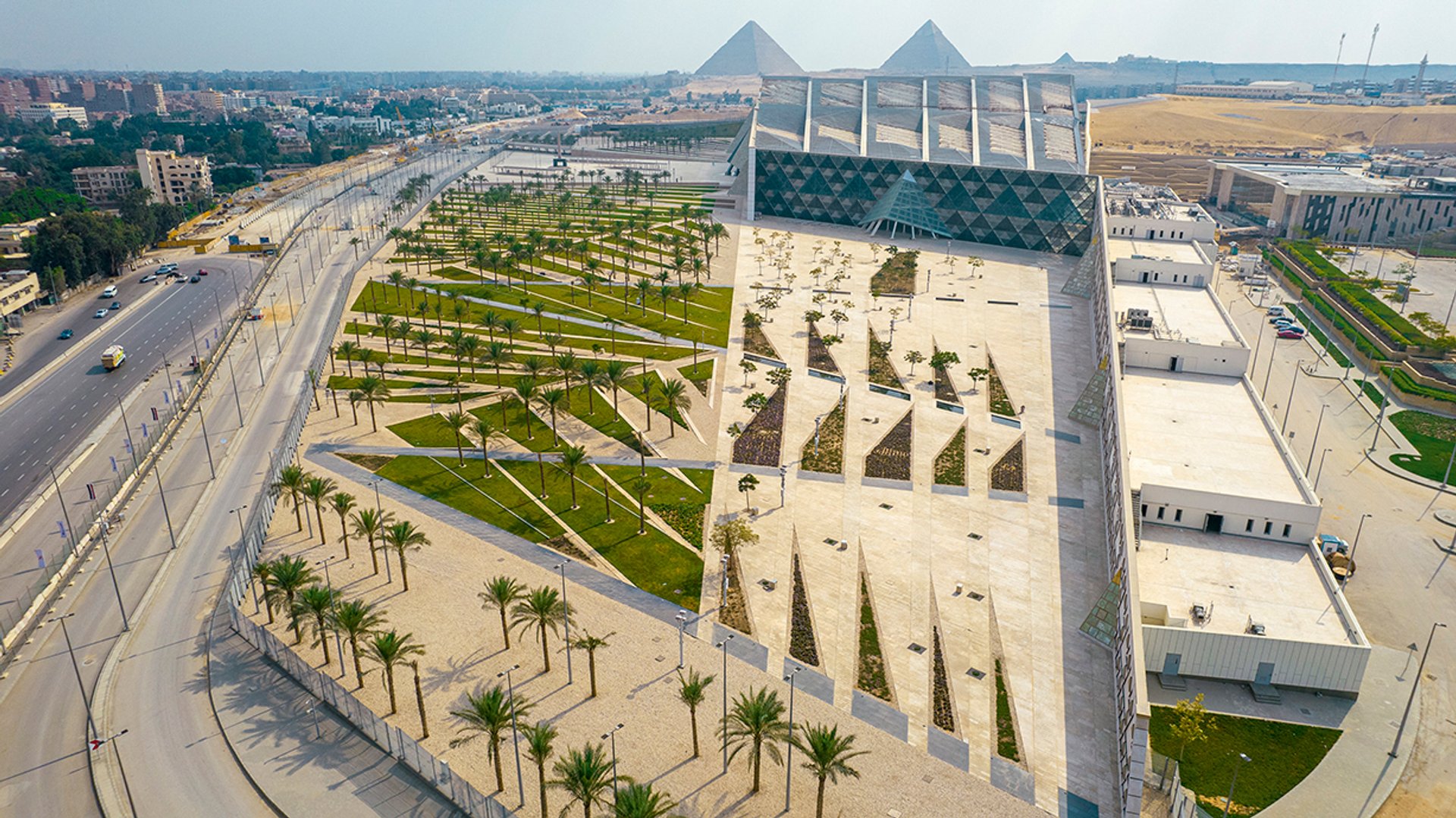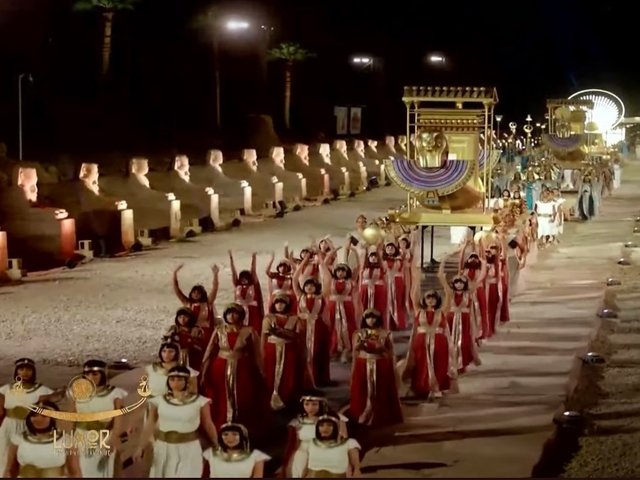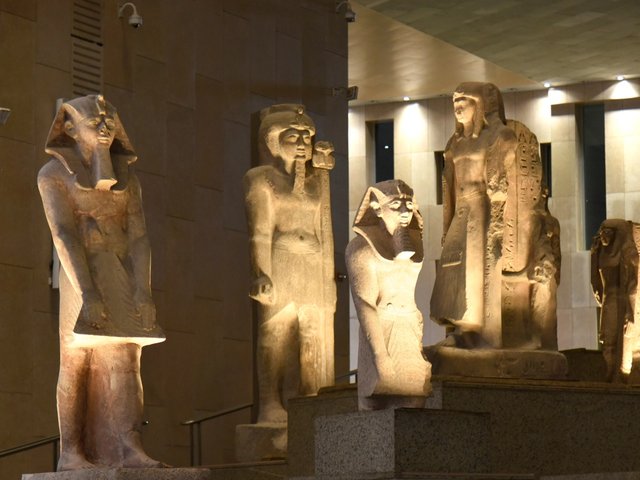It feels fitting that the mystery surrounding the official opening date of Cairo’s Grand Egyptian Museum seems to mirror the enduring enigma of how its magnificent neighbours, the ancient pyramids of Giza, were built. Its completion has been repeatedly delayed since it was first announced in 2002.
The most recent announcement was made on 28 January when, during an interview on a popular Egyptian talk show, the chief executive, Ahmed Ghoneim, said the museum would celebrate its official opening on 3 July.
Nevertheless, 60% of the largest archaeological museum in the world is now open. Its expansive, low-rise structure may lack the charm of Cairo’s crumbling historic institutions, but its scale—it covers 5.2 million sq. ft.—allows for much needed breathing room around the colossal monuments it houses, amplifying the grandeur.
Visitors ascend a wide slope—home to the world’s first hanging obelisk—towards a pyramid-shaped doorway flanked by hieroglyphs. Inside the vast atrium, a monumental, 3,200-year-old statue of Ramesses II stands in quiet command, encircled by shallow pools. The grand staircase, lined with well-lit and meticulously labelled pharaonic statues, leads to a viewing platform with a breathtaking vista of the Giza pyramids. Echoes of Egypt’s ancient design permeate the interiors, from the angular windows to the sloping ceilings, while the museum’s precise geometric alignment with the pyramids extends into its landscaped gardens, reinforcing the dialogue between past and present.

The Grand Egyptian Museum, with the Giza pyramid complex in the background
© Grand Egyptian Museum
Missing king
But what of the collection itself? In January, the museum was still missing its greatest treasure: the contents of the tomb of Tutankhamun, including his golden funerary mask, sarcophagus and throne. Before the much anticipated opening, the full King Tutankhamun collection will move into a dedicated gallery, the museum says.
With thousands of objects spanning five millennia, curating a coherent visitor experience is no small feat. At the entrance to the 12 galleries, a diagram outlines the exhibition’s structure: a horizontal timeline traces Egypt’s history from its earliest beginnings to the Greco-Roman era, while a vertical division explores key themes—society, kingship and beliefs.
The layout is clearly articulated, allowing for navigation without the need for a guide. Nevertheless, on my visit there were many Egyptologists herding crowds of tourists and speaking several languages. Our guide was informative, knowledgeable and, as is common among Egyptians, very patriotic.
Pioneers
“Egyptians invented Tupperware!” she exclaimed as she pointed out the varying sizes and shapes of clay pots for storing food. “They were the first to wear make-up,” she said as we swept past vitrines of ancient cosmetic palettes and tools used to apply kohl to the eyes. “We also invented games,” she smiled, pointing to a carved board game.
The list went on as we traversed the halls and while her claims were not unfounded, her enthusiasm was what stayed with me. If there is one thing Egyptians do well it is celebrating their own. And despite the setbacks in opening and criticism of high entrance fees (1,200 Egyptian pounds, about $24), the museum is well worth celebrating.
Its polished floors, clean toilets, high-quality restaurants and well-stocked gift shop full of local products such as alabaster from Luxor, pottery from Fayum and hand-made scarves from Siwa, set it apart from many Cairo institutions and indeed, the chaotic streets outside.
But despite its newness, some areas still feel dated. The digital and multimedia technology is basic, and although the photobooths in the main foyer provide amusement for visitors, their quality could be greatly improved.
Repeat business
Thanks to a public-private partnership with Hassan Allam Holding, the museum is positioning itself as a cultural hub, aiming to contribute to the local economy, celebrate and support the creative community and, importantly, keep visitors coming back.
This is reflected in a roster of robust cultural programming that goes beyond the collection itself. In 2023, the museum commissioned the German-Egyptian artist Susan Hefuna for Traces of Egypt, an exhibition of 28 textile pieces made in collaboration with local artisans skilled in khayamiya appliqué sewing. It has held three editions of both Art Cairo and RiseUp Summit (an entrepreneurship event for young innovators), and also hosts Cairo Food Week. The Urban Spaces of Cairo: Past, Present, and Future exhibition was held in partnership with UN-Habitat in November, as was a series of masterclasses for Egypt’s aspiring classical musicians led by professors from London’s Royal College of Music.
When it does fully open, the Grand Egyptian Museum will certainly be more than an interestingly exhibited collection of artefacts. It will be a place for innovation and creativity, as well as a must-visit on Egypt’s already well-trodden tourist trail.






